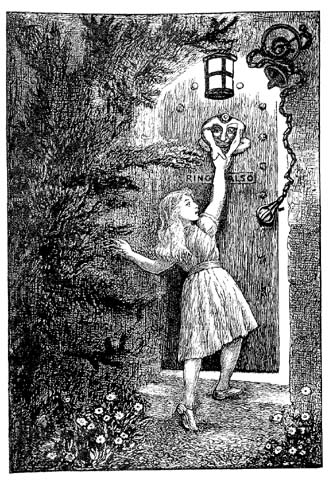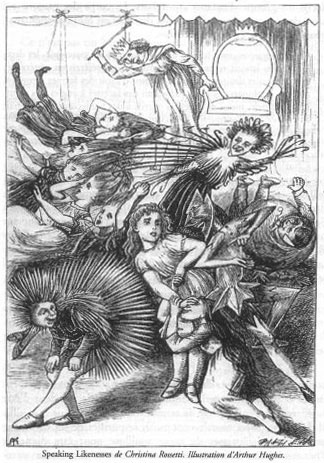
Please note: this post covers only 1 of the stories in Speaking Likenesses. Although the last is also cited to have Carroll-esque inflections, I only feel that Flora’s story is Carrollian enough to be talked about.
Can be read: Via archive.org as part of the public domain.
Written by Dodgson’s contemporary, Rossetti, Speaking Likenesses is an anthology of several loosely linked stories as told by an aging mother to her three girls. I’m going to disagree with many studies of this novella and instead go with the view that Rossetti was not using these stories to criticize or mock Dodgson’s Alice tales. If anything, Rossetti’s stories also mock the inane moralism of children’s tales similarly to Carroll, albeit in a less restrained fashion. Evidence of this can be seen in the silly, trivial questions that the three sisters ask the mother, and the mother’s often overzealous use of moralising in her tales.
With that out of the way, let’s take a look at the 2nd tale of the three, Flora’s story. Flora’s character has several Alice-based personality features. Namely her unshakable sense of curiosity and her ability to keep her sense about her during her often surreal, and in this case, rather unpleasant encounters. Although the mother when telling the story points to Flora’s imperious nature when trying to control her friends after they fight at her birthday, the mother fails to understand that Flora’s temper giving way to anger over her friends would only be natural. It’s not like she hasn’t tried to stop her friends from fighting. Overall despite her flaws Flora is generally conveyed as a nicer child than the mother’s view paints her as.
Carroll’s novels often play upon the uncanny via the Duchess and Queen of Hearts in Wonderland, and the train passengers, sheep and mutton meal in Looking-Glass. But their vague uneasiness is not brought to the centre. Alice moves on, barely dwelling on each encounter. Even the Queen of Hearts is just a bit player of a larger narrative. In Rossetti’s likenesses, Flora may go through a door but she does not end up in a world of wonder by any sense. Through the door is a warped version of a birthday party, where each uncanny resident is downright horrendous towards Flora.

Although the curious mirrored walls and anthropomorphic chairs recall Carroll, they are only used as operators to deny Flora of any joy. A sort of inverse form of Carrollian writing then.
Flora is denied food by the self-proclaimed Birthday Queen, and then subjected to having pins thrown at her as a party game. Although Carroll’s Alice may suffer threats of beheading or disappearing altogether, she is never really physically harmed. But Flora very much is.
And how much does Flora learn from her experience? Other than never to fall asleep in the garden ever again? Or never to go through any unusual doors?
The moralistic mother tells us as readers it’s for her own good. That in the future, Flora will become a proper Victorian lady because of this dream. But this statement rings entirely false. And yes, that’s the point.
In mocking the Mother character, Rossetti aims all her scorn at moralistic adults who enforce strict rules on children and pointless lessons for their supposed own good.
Can't help but wonder if Rosetti was inspired by Carroll's Duchess.
Everything has a moral, if only you can find it.
Indeed!